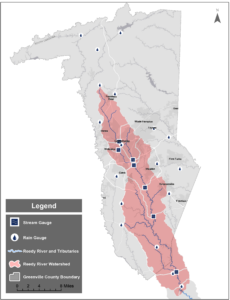Water quality standards are established by the US Environmental Protection Agency, then adopted or made more stringent by the state’s delegated authority. For South Carolina, this is the South Carolina Department of Health and Environmental Control (SCDHEC). SCDHEC establishes water quality standards which waterways must meet. If the waterway does not meet its standard on a frequent basis (such as nitrogen), then the waterway becomes listed for that parameter on the state’s biannual 303(d) List of Impaired Waterbodies.
Basic measurements that are used to determine a river’s health are the following:
- pH - the measure of acidity of a waterway; changes can indicate contamination; heavily influences biological activity in a river for fish, macroinvertebrates, and wildlife.
- Dissolved Oxygen (DO) – measure of oxygen dissolved in the water; indicator of stress on the river and its ecosystem; required for life.
- Temperature – thermal stress is a potential pollutant in urban areas, where industrial process water or warm stormwater runoff flows directly from parking lots to waterways. Temperature affects wildlife and biological activity and influences how much oxygen the waterway can hold.
 Nutrients play a critical role in waterways, driving algal growth, and affecting the balance of available dissolved oxygen for life. For our purposes, we are referring to phosphorus and nitrogen when we discuss nutrients.
Nutrients play a critical role in waterways, driving algal growth, and affecting the balance of available dissolved oxygen for life. For our purposes, we are referring to phosphorus and nitrogen when we discuss nutrients.
Bacteria is another parameter monitored by the state. In freshwater, the standard is to measure Escherichia coli, or E. coli, to indicate the presence of fecal waste in waterways and the potential threat of viruses and pathogens. This presence of bacteria (and viruses) can be harmful to people and pets alike.
Although sediment transport is a natural function of a waterway, excessive sediment is considered to be one of our most significant pollutants, though SC has no standard for measuring the impact or significance of this pollutant in creeks or rivers. Sediment covers and interrupts habitat for macroinvertebrates (the bottom of the food chain for fish) and carries other pollutants with it, attached to the sediment particles. This includes nutrients and metals. Sediment is also regularly correlated to bacteria, meaning that with increased sediment, bacteria populations also increase.
The Reedy River and its tributaries meet or exceed water quality standards for dissolved oxygen and pH, while temperature and phosphorus concentrations have improved dramatically. There is room for improvement in nitrogen meeting in-stream standards at many locations for biological health and E. coli. The adjacent map shows locations where Greenville County is actively collecting data to measure water quality.
The Good News
Since the 1990's, phosphorus concentrations have decreased by more than half throughout the Reedy River watershed. In fact, the Reedy was removed from SCDHEC's impaired water list for phosphorus at Boyd's Millpond in 2016.
The general population has an active, individual role to play in lowering nitrogen levels in the river.
Additional data is now being collected through the SC Adopt-a-Stream program, an active citizen science network.
Greenville County and the City of Greenville continue to maintain their stormwater management programs with a major element to reduce erosion (ie. sediment) during construction.
In addition, ReWa has invested in nutrient removal upgrades at their two water resource recovery facilities to reduce phosphorus discharged to the river by more than 90%.
The Bad News
Lake Greenwood and Boyd’s Mill Pond, lakes fed by the Reedy River, have an excess of nitrogen, based on the SCDHEC lake standards. Unfortunately, increased population means that it is likely that these levels will increase because of the nature of population density on rivers.
